Learning Outcomes
Upon the completion of this lesson, you should be able to:
- Understand the Psychoanalytic Theory
- Understand the Gestalt Theory
- Understand the Behaviourist Theory
- Understand the Cognitive Theory
INTRODUCTION
“Creativity is the step child of psychology” (May, 1975). This statement characterizes the historically difficult relationship existent between gifted individuals and society and, between science and creativity research. Just so, the creative process can be observed and described but its source remains obscure. Psychology’s numerous philosophical orientations have each attempted a meaningful relationship with this “step child” with varying degrees of success. This chapter will discuss the psychoanalytic, Gestalt, developmental growth, behaviourist and cognitive theory in relation to arts. Each of these branches holds a sharply different view on the nature of man which reflects in each psychology’s explanation of creativity, its source and purpose.
PSYCHOANALYTIC THEORY
Sigmund Freud born Sigismund Schlomo Freud (6 May 1856 – 23 September 1939), was an Austrian neurologist who founded the discipline of psychoanalysis. Freud’s family and ancestry were Jewish. Freud always considered himself a Jew even though he rejected Judaism and had a critical view of religion. Freud’s parents were poor, but ensured his education. Freud was an outstanding pupil in high school, and graduated the Matura with honors in 1873. Interested in philosophy as a student, Freud later turned away from it and became a neurological researcher into cerebral palsy, Aphasia and microscopic neuroanatomy.
Sigmund Freud, founder of Psychoanalysis, had theory commonly referred to as the iceberg theory in which he proposed to split the human into three levels of consciousness. He said that every human had an unconscious, a preconscious, and a conscious level to their minds. According to his theory the unconscious mind was the largest part, but also was the hidden or repressed part.
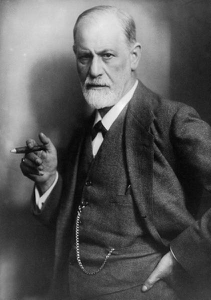
Id, Ego and Superego
As is well-known, Freud divided the human psyche into three interactive components. Wholly unconscious and the seat of powerful, instinctive drives, many of them sexual, was the id. The largely conscious component attempting to reconcile the id to the world outside was the ego. The third, relatively independent component, was the superego, which internalized parental and social demands and acted as censor over the ego’s activities. Disharmony between the three components led to mental disorders, which could be investigated in dreams, free association sessions and art.
According to Freud, we are born with our Id. The id is an important part of our personality because as newborns, it allows us to get our basic needs met. Freud believed that the id is based on our pleasure principle. In other words, the id wants whatever feels good at the time, with no consideration for the reality of the situation. When a child is hungry, the id wants food, and therefore the child cries. When the child needs to be changed, the id cries. When the child is uncomfortable, in pain, too hot, too cold, or just wants attention, the id speaks up until his or her needs are met.
The id does not care about reality, about the needs of anyone else, only its own satisfaction. If you think about it, babies are not real considerate of their parents’ wishes. They have no care for time, whether their parents are sleeping, relaxing, eating dinner, or bathing. When the id wants something, nothing else is important.
Within the next three years, as the child interacts more and more with the world, the second part of the personality begins to develop. Freud called this part the Ego. The ego is based on the reality principle. The ego understands that other people have needs and desires and that sometimes being impulsive or selfish can hurt us in the long run. It is the ego’s job to meet the needs of the id, while taking into consideration the reality of the situation.
By the age of five, or the end of the phallic stage of development, the Superego develops. The Superego is the moral part of us and develops due to the moral and ethical restraints placed on us by our caregivers. Many equate the superego with the conscience as it dictates our belief of right and wrong.
In a healthy person, according to Freud, the ego is the strongest so that it can satisfy the needs of the id, not upset the superego, and still take into consideration the reality of every situation. Not an easy job by any means, but if the id gets too strong, impulses and self gratification take over the person’s life. If the superego becomes to strong, the person would be driven by rigid morals, would be judgmental and unbending in his or her interactions with the world. You’ll learn how the ego maintains control as you continue to read.
Freud’s Iceberg Theory
According to Freud, there are three levels of consciousness:
- Conscious (small): this is the part of the mind that holds what you are aware of. You can verbalize about your conscious experience and you can think about it in a logical fashion.
- Preconscious (small-medium): this is ordinary memory. So although things stored here are not in the conscious, they can be readily brought into conscious.
- Unconscious (enormous): Freud felt that this part of the mind was not directly accessible to awareness. In part, he saw it as a dump box for urges, feelings and ideas that are tied to anxiety, conflict and pain. These feelings and thoughts have not disappeared and according to Freud, they are there, exerting influence on our actions and our conscious awareness. This is where most of the work of the Id, Ego, and Superego take place.
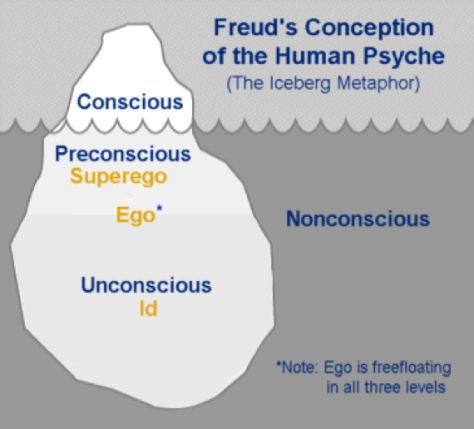
Freud Creative Process
What is creativity? What goes on during this process? Psychoanalysis gives us certain explanations on how this process is possible, and also on its benefits for both its author and public.
The creative process is, according to Freud, an alternative to neurosis, that is a defense mechanism protecting against neurosis, leading thus to the production of a socially acceptable source of entertainment and pleasure for the public. For the artist has the ability of turning his fantasies into artistic creations instead of into symptoms.
The unconscious plays a major role in the act of creation. That is, the act of creation is made possible by the libido, the energy of the id, and by a defense mechanism considered to be the most beneficial – sublimation. By turning the sexual desire into a cultural manifestation with the help of the ego, sublimation makes the thoughts of the unconscious more acceptable to the conscious and it also allows for something productive, and pleasant, for the others as well.
Art makes use of defense mechanisms such as condensation and displacement – terms also used for work on the dream process, due to the role of the unconscious in both creative and dream processes.
Art itself can be regarded as a defense mechanism. The artistic creation may be, for the artist, wish fulfillment or fantasy gratification of desires denied by the reality principle or prohibited by moral codes. Art is thus a means of giving expression to, and dealing with, various psychic pressures. The artist can work his fantasy – a substitute for satisfaction – by means of sublimation, into a socially acceptable form, art, that the others can enjoy. He works out the personal in his daydreams, fantasies into something he can share with the public.
Art is seen as a path linking fantasy and reality, the artist being able to regain contact with reality. Freud compares the artists’ fantasies with children’s fantasies: play involves control – keeping in touch with reality – as much as fantasy. Similarly to a child’s play, the artist’s fantasy moulds the external world to his desire, creating a world of fantasy where he can fulfill his unconscious wishes.
Some believe that creativity is intertwined with repression and pain. Freud did claim that the artists use their work to project in the outside world unfulfilled fantasies. However, in his view, a good poem is sublimation, and not a repression. Moreover, there is this ability of the artist to create and not become ill with neurosis.
The Application of Psychoanalytic Theory in the Arts Teaching and Learning
As an art teacher, an understanding of the theory of psychoanalysis will help teachers deal with students feeling and problem. The teachers must understand the three basic techniques for treating his students, namely:
- Identifying the problem. Students who are experiencing emotional stress will report every single thing that comes to their The teachers will interpret it in a form of conversation. The teacher is encouraged to recognize the barriers and to diagnose problems and provide individualized interventions and services to help the student.
- Transferring the emotion. The students are encouraged to direct their emotions to the teachers. Then, the teacher will need to look to the behavior of his students.
- Interpretation of dreams. Interpretations made spontaneously. The students’ unconscious condition will be interpreted like a dream. The teachers will interpret the dreams and try to understand the problem in depth.
The art teachers are required to access and address student needs. As a natural mode of communication for children, it is a means of externalizing the complexities of emotional pain. One of the solutions is to perform art therapy. Children rarely resist the art-making process because it offers ways to express themselves that are less threatening than strictly verbal means.
In the art therapy process, children are encouraged to visually represent their thoughts and feelings, such as conflicts, wishes, and memories. Utilizing their artwork and verbalizations, they are helped to understand how they function as individuals and as part of a family and group system. Art therapy treatment in schools is art expression that lends itself to exploration, and as a result, to the adjustment of individuals to life.
GESTALT THEORY
The Gestalt movement, pioneered by Max Wertheimer (1880 – 1943), Kurt Koffka (1886 – 1941) and Wolfgang Köhler (1887 – 1967) emerged in Germany in 1912 and, until 1933, exercised “a dominating influence on German psychology”.
Gestalt means when parts identified individually have different characteristics to the whole (Gestalt means “organised whole”) e.g. describing a tree – it’s parts are trunk, branches, leaves, perhaps blossoms or fruit. But when you look at an entire tree, you are not conscious of the parts, you are aware of the overall object – the tree. Parts are of secondary importance even though they can be clearly seen. Gestalt is a perspective focuses on the belief that human consciousness cannot be broken down into its elements.

Gestalt psychology (also Gestalt of the Berlin School) is a theory of mind and brain that proposes that the operational principle of the brain is holistic, parallel and analog with self-organizing tendencies, of that the whole is different from the sum of its parts. The Gestalt effect refers to the form-forming capability of our senses, particularly with respect to the visual recognition of figures and whole forms instead of just a collection simple lines and curves. Figure shows an example of picture that contains the gestalt theory.
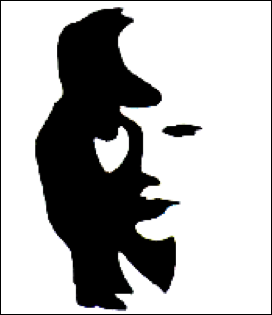
The word Gestalt in German literally means “shape” or “figure”. Gestalt is also known as the “Law of Simplicity” or the “Law of Pragnanz” (the entire figure or configuration), which states that every stimulus is perceived in its most simple form. In German, pragnanz means clarity, so laws of pragnanz are laws of clarity. The law of Pragnanz is also known as the law of a good figure or the law of simplicity. The most common translation is laws of good form. A law of pragnanz identifies an organizational tendency, a way in which the human brain decides that things go together. Objects in the environment are seen in a way that makes as simple as possible. The Law of Pragnanz translates into the idea that people will perceive the best thing that are presented to them. Sometimes it is hard to follow the law of pragnanz, which is the case of the impossible figures, or shapes (abstract).
Gestaltists performed many researches on perception and human learning. They believed learning is the result from good perception, which enable an individual to form correct concept in their mind. Later on they proposed the principles of law for perceptual organization. Henceforth, we will discuss these principles which consisted of six principles, which are good form, figure or ground, similarity, proximity, closure and continuity.
The Law of Good form or Pragnanz
The word ‘Gestalt’ means ‘form’ or ‘shape’. Gestalt psychologists were of the view that psychological organization will always be as ‘good’ as prevailing conditions allow. For Gestalt psychologists, firm is the primitive unit of perception. When we perceive, we will always pick out form. Our perceptions are influenced by our past experiences. This principle is also called Pragnanz Law, (Tan Oon Seng et al., 2003)
The Law of Figure – Ground Discrimination
The Rubin vase shown in figure is an example of this tendency to pick out form. We do not simply see black and white shapes; we also see two faces and a vase. What about Figure 10.6? Do you see a young lady or an old lady?
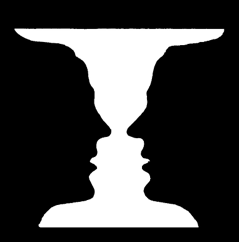
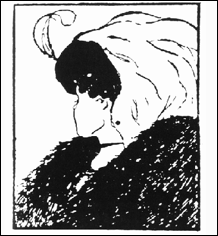
The problem here is that we see the two forms of equal importance. If the source of this message wants us to perceive a vase, the vase is the intended figure and the background is the ground. The problem here is a confusion of figure and ground.
The Law of Proximity


Things, which are closer together in space of time, tend to be perceived as grouped together. Thus, if you want your audience to associate the product with the presenter, put them close together; if you want them to perceive two ideas as associated, present them in close proximity.
The Law of Similarity
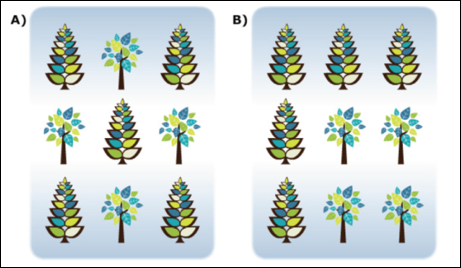
Things that are similar are likely to form ‘Gestaltes’ as groups. So, in the graphic labelled A (on the left), you probably see an X of fir trees against a background of the others. In the graphic labelled B (on the right), you may see a square of the other trees, partly surrounded by fir trees. The fact that, in picture labelled with A, we see an X while in the picture labelled with B, we can see a square, an example of good form or Pragnanz.
The Law of Closure
Perceptually, we have the tendency to fill in the gaps. In other words, we can still read WASHO, see the square and read ‘perception” despite the missing information. You probably know that redundancy can be deliberately added into messages to increase the likely fidelity of reception, but the Gestalt psychologists law of closure suggests that it certainly is not always necessary.
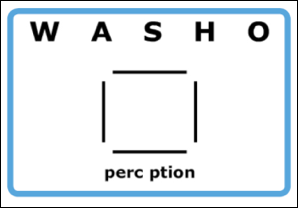
The Law of Continuity
When you see figure (1), you are likely to see it as consisting of two lines like (1a), rather than of the two shapes (1b). This is the Gestalt principle of continuity which saw a single unbroken line is likely to be seen as an entity.
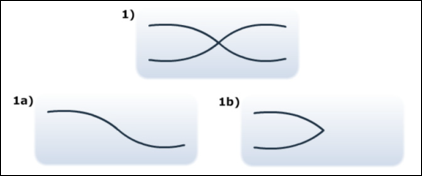
When you see figure (2), you are much more likely to see it as consisting of two lines like (2a and 2b), rather than as the series of shapes (2c).
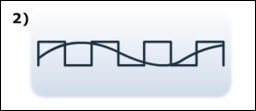
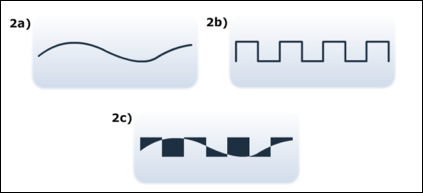
Perceptually, where figures are defined by single unbroken like, they tend to be seen as an entity. This principle is of course of particular importance in teaching. Even something as simple as drawing a squiggle to link up apparently disparate elements on a page can be helpful in suggesting to the reader that they are parts of a whole.
The Application of Gestalt Theory in the Arts Teaching and Learning
This theory applies to the brain as a whole and is not partly delivered. According to Rudolf (1945) the appearance of the object depends on the location and the function is viewed as a whole.
When analyzing children’s drawing, they often make modifications to the drawn images from the observed image. According to Feldman, there are two types of images in children’s painting:
- Intracerebralimagecontained from thechildren’s observation.
- b. Images displayed are drawn from children’s artistic point of view.
As an art teacher, we need to understand the validity of this theory when viewing the images in the children’s painting. While painting, children often make modifications to the image seen. Why is it happened? There are four factors that influence the children to change the image drawn, namely:
- The modification effect when converting the optical stimulus to the brain cerebral.
- b. The modification effect of the notion in the process of finding a suitable image.
- c. The modification effect when using media images and the artistic process.
- d. Children’s brain psychomotorcoordination
As an art educator, we must accept the fundamental nature of the effects of the children. With only a spot of colour, it can create a never ending story. Thus in childhood, we are not able to measure their intelligence by just looking at the images in their works. Based on the statement, art teachers are not supposed to measure the intelligence of a child based on the visual found in their drawing.
As an art teacher, observation plays a crucial role in translating each image seen and observed. Not all pupils are able to make the same observation even though they belong in the same age group. In art education, teachers can play an important role in the motivation to balance the mental and cognitive of the children.
BEHAVIOURIST THEORY
Behaviorism, also known as behavioral psychology, is a theory of learning based upon the idea that all behaviors are acquired through conditioning. Conditioning occurs through interaction with the environment. Behaviorists believe that our responses to environmental stimuli shape our behaviors.
According to behaviorism, behavior can be studied in a systematic and observable manner with no consideration of internal mental states. This school of thought suggests that only observable behaviors should be studied, since internal states such as cognitions, emotions and moods are too subjective. Other leading figures in behaviorist theory are Edward L. Thorndike, B.F. Skinner, John B. Watson and Ivan Pavlov. In this section, we will look at the application of the principles of classical conditioning and operant conditioning
Classical conditioning
The concept of classical conditioning was developed by a Russian physiologist, Ivan Pavlov (1849-1936). Classical conditioning is a type of learning which based on the association of a stimulus that does not ordinarily elicit a particular response with another that does elicit the response. From the definition, we understand that the key element in classical conditioning is association. It means that if two stimuli repeatedly experienced together, they will become associated. For example, if a student frequently encounters unpleasant stimuli in Mathematics class such as unfriendly teachers, difficult questions, and a lot of homework, he may learn to dislike Mathematics.
Pavlov’s Experiments
Pavlov discovered classical conditioning almost by accident. Originally, he wanted to study the role of salivation indigestion. He measured how much saliva dogs produce when given meat. After a few days in the experiment, Pavlov noticed that the dogs in his laboratory started salivating when the lab attendant entered the room with the meat dish, before meat was placed in their mouth.
This aroused Pavlov’s curiosity and he pursued the issue with more experiments. For example, he sounded a bell just before presenting his dogs with food. After hearing the bell many times right before getting fed, the dogs began to salivate as soon as the bell rang. In other word, the dogs had been conditioned to salivate in response to a new stimulus (the bell) that normally would not produce salivation. The dogs had learned to associate the bell with food. Types of Stimulus and Response are an observable environmental event that has a potential to exert control over a behavioural response. A response is an over behaviour by a learner. Put it in a simpler way, a stimulus is anything that can directly influence behaviour and the stimulus produces a response.
In classical conditioning, there are 2 types of stimulus and 2 types of response. They are unconditioned stimulus, conditioned stimulus, unconditioned response, and conditioned response as explained in this figure.
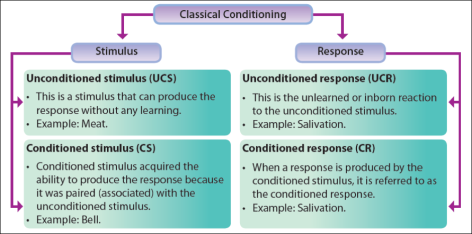
Look at Figure to help us understand the meaning of these stimulus and responses as well as the steps in the process of classical conditioning.
Figure Process of classical conditioning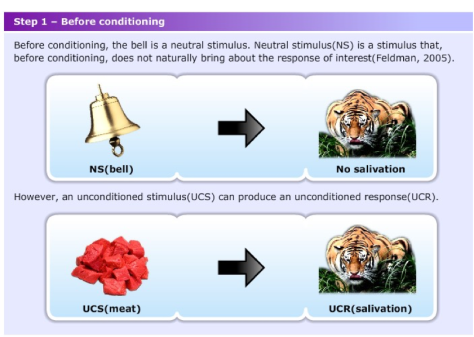
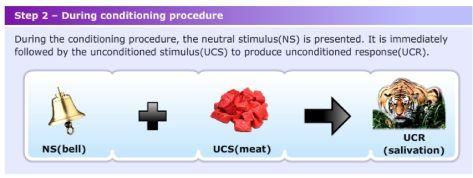
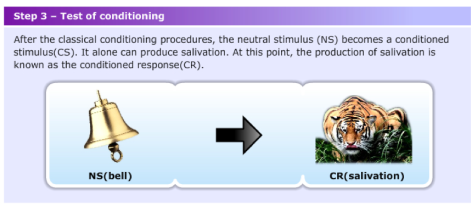
Operant Conditioning
Operant or instrumental conditioning is a form of learning in which the consequences of behaviour lead to changes in the probability that the behaviour will occur. Thorndike (1874- 1949) was the pioneer in studying this kind of learning. His famous formulation of Law of Effect lies at the heart of the operant conditioning. The Law of Effect states that behaviour that brings about a satisfying effect (reinforcement) is apt to be performed again, whereas behaviour that brings about negative effect (punishment) is apt to be suppressed (Morris & Maisto, 2001).
Types of Reinforcement and Punishment
Reinforcement is a consequence that increases the probability that behaviour will occur. On the other hand, punishment is a consequence that decreases the probability behaviour will occur. Put it another way, reinforcement will strengthen a behaviour while punishment will weaken a behaviour. There are 2 forms of reinforcement and punishment as shown in figure
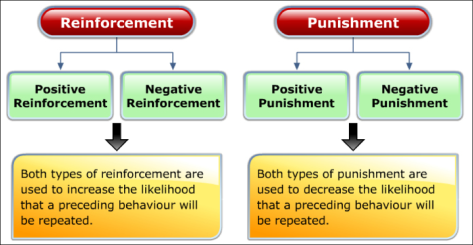
Take note that when something is added or presented, the process of learning is called positive and when something is removed or taken away, the process of learning is called negative. Table 10.15 helps us to understand these forms of reinforcement and punishment.

Behaviourism in the Classroom
This section describes how teachers can apply the principles of behaviourism in the classroom. It is divided into three subsections according to the perspectives discussed earlier that are classical conditioning, operant conditioning and social learning theory.
Applying Classical Conditioning in the Classroom
The key element in classical conditioning is association. Therefore, teachers are encouraged to associate variety of positive and pleasant events with learning and classroom activities. For example, a teacher may:
- Use attractive learning aids.
- Decorate the classrooms.
- Encourage students to work in small groups for difficult learning tasks.
- Greet the students and smile at them when he comes to the classroom.
- Inform the students clearly and specifically the format of quizzes, tests, and examinations.
- Make the students understand the rules of the classrooms.
- Give ample time for students to prepare for and complete the learning tasks.
Applying Operant Conditioning in the Classroom
In operant conditioning, the consequences of behaviour produce changes in the probability that the behaviour will occur. Reinforcement and punishment are the 2 main concepts in operant conditioning. The following are some examples on how operant conditioning can be applied in the classrooms.
- Recognize and reinforce positive behaviours and genuine task accomplishments.
- Use various types of reinforcement such as teacher approval (praise, smiles, attention, and pats on the shoulder), concrete reinforcement (cookies, candies, and stationeries) and privileges (longer recess time and more time with friends).
- Reinforce good behaviours and punish bad ones consistently.
- Use schedule of reinforcement, such as surprise rewards, to encourage persistence.
- Use positive punishment as the last option. Use negative punishment, such as detention class, instead.
- Punish students’ behaviour, not their personal qualities.
- Tell the students which behavior is being punished.
COGNITIVE THEORY
The “Cognitive revolution” is the name for an intellectual movement in the 1950s that began with what are known collectively as the cognitive sciences. It began in the modern context of greater interdisciplinary communication and research.
The relevant areas of interchange were the combination of psychology, anthropology and linguistics with approaches developed within the then-nascent fields of artificial intelligence, computer science and neuroscience. Two of the prominent figures in cognitive psychology are Jean Piaget (1896 – 1980) and Lev Vygotsky (1896 – 1934).
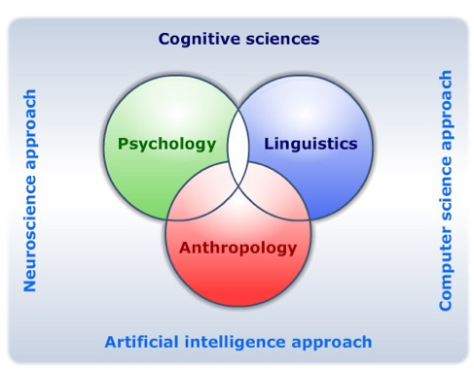
The cognitive revolution in psychology was a response to behaviourism, which was the predominant school in experimental psychology at the time. This school was heavily influenced by Ivan Pavlov, B.F. Skinner, and other physiologists. They proposed that psychology could only become an objective science if it is based on observable behaviour in test subjects. Since mental events are not publicly observable, behaviourist psychologists avoided description of mental processes or the mind in their literature.
Psychoanalytic theories on the other hand stress the importance of the unconscious while cognitive theories emphasize on conscious thoughts. 3 important cognitive theories are Piaget’s cognitive developmental theory, Vygotsky’s sociocultural cognitive theory and information processing theories.
Cognitive Psychology focuses on the study of how people think, understand, and know. They emphasizes on learning how people comprehend and represent the outside world within themselves and how our ways of thinking about the world influence our behaviour.
From a cognitive learning perspective, learning involves the transformation of information in the environment into knowledge that is stored in the mind. Learning occurs when new knowledge is acquired or existing knowledge is modified by experience. Among the main issues studied and discussed by cognitive psychologists are:
- The cognitive theories present a positive view of development, emphasizing conscious thinking.
- The cognitive theories (especially Piaget’s and Vygotsky’s) emphasize on the individual’s active construction of understanding.
- Piaget’s and Vygotsky’s theories underscore the importance of examining developmental changes in children’s thinking.
- The information processing theory offers detail descriptions of cognitive processes.
Cognitive Structuralism
Cognitive structuralism was founded by Jean Piaget (1896-1980) and other cognitive psychologists. Whereas social constructivism was founded by Vygotsky (1896-1934). There are several opinions related to cognitive structuralism according to psychologists. According to Leinhardt (1992), “The awareness of interrelationships between stimuli or the use of appropriate schemata is significant to cognitive learning and to teaching and classroom learning”.
According to Leinhardt, Byrness, “Schemata serve several functions in learning: categorizing, remembering, comprehending and problem solving. First, schemata or prior knowledge links categorize our experiences more efficiently for processing. This categorization of information facilitates the processes of remembrance (recall), and comprehension (understanding), all of which make problem solving more productive”.
Alba and Hasher (cf. Benjafield,) suggest that, “Schema facilitates the selection of information based on our interests. Further, once selected, the schemas enable the selected material to be organized abstractly and assist the individual in the processes of interpreting and integrating the new material, based on what he or she knows already”
Although cognitivists like Jerome Bruner and David Ausubel described ways of utilizing schema theory in classroom learning, but their perspectives on the structuring of prior knowledge linkages differed. David Ausubel (1968) is a psychologist who advanced a theory, which contrasted meaningful learning from rote learning. In Ausubel’s view, “To learn meaningfully, students must relate new knowledge (concepts and propositions) to what they already know.”
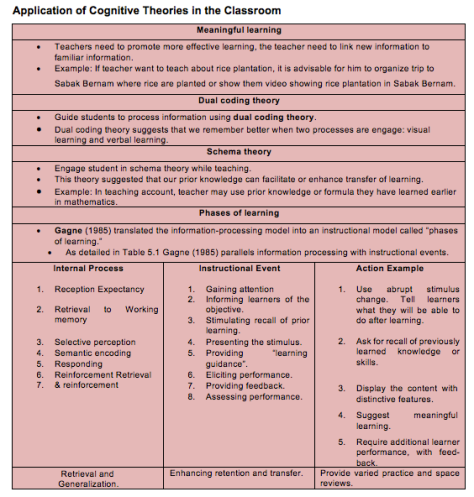


4 thoughts on “Learning Theories in Art Education”